 |
|
Here and There introduces art, artists, galleries and museums around Japan that non-Japanese readers and first-time visitors may find of particular interest. The writer claims no art expertise, just a subjective viewpoint acquired over many years' residence in Japan.
|
|
 |
|
|
 |
 |
Art for Otaku: Trains at the Taro
Alan Gleason |
 |
|
Bunpei Kado's Detached-House Condominium (2012), steel, stainless steel, and wood, 1300 x 1300 x 2500 mm (left), and Giraffes (2006), steel and wood, 2000 x 1000 x 4000 mm (right). Between them runs Taira Ichikawa's Generic Art Line (2013). |
Few modes of transport make the otaku heart beat faster than trains do, and nowhere so much as in Japan, where camera-wielding trainspotters crowd around rail crossings to snap their favorite rolling stock as it whizzes by. Rarely, however, does one associate trains with avant-garde art. If you're a contemporary art and train buff, though, I have just the show for you: Railway Art Museum at the Taro Okamoto Museum of Art.
Okamoto (1911-96) was the grand old man of Japan's postwar avant-garde, a larger-than-life artist with a very public persona. His Tower of the Sun loomed over Osaka's Expo '70, and a TV commercial in which he leeringly declared that "Art is an explosion!" made him a celebrity in his own time. Okamoto's fame remains undiminished today; his powerful anti-nuclear mural Myth of Tomorrow hangs in one of Tokyo's busiest train stations, and the metropolis boasts two museums devoted to his work (previously introduced here in Artscape).
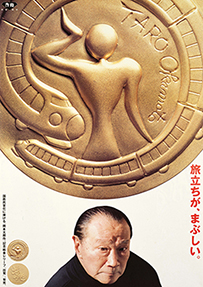 |
|
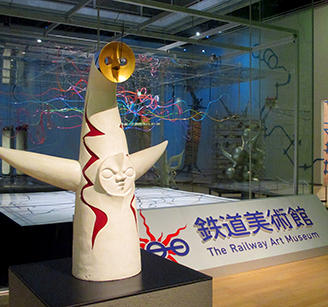 |
|
Japan Railways (JR) poster showing Taro Okamoto and his gold medal Departure (1987), commemorating the railway system's privatization. |
|
Replica of Okamoto's Tower of the Sun, with Takatsugu Kuriyama's Tokyo Arteries behind. The actual tower still stands in Expo Commemoration Park outside Osaka, and is currently being renovated for eventual reopening to the public. |
One of these, the Taro Okamoto Museum in Kawasaki, the artist's birthplace, is where to go through 10 October for an entertaining dose of art about trains. Okamoto's own association with railroads included several commissions for murals and statuary in stations around the country. In 1987 he was hired to design gold and silver medals commemorating the privatization of the Japan National Railways, replicas of which appear in this exhibition. But the most interesting displays are by younger artists who have been invited to submit train-themed works for the occasion.
As one might hope and expect, the main exhibit area is built around a model railroad -- but no ordinary one. Taira Ichikawa's Generic Art Line consists of a single track along which an electrically driven car, modeled after Tokyo's Yamanote Line, shuttles leisurely back and forth on a route flanked by scale models of Okamoto's sculptures. A gigantic light bulb perched atop the car casts shadows on the walls that further distort Okamoto's whimsical shapes.
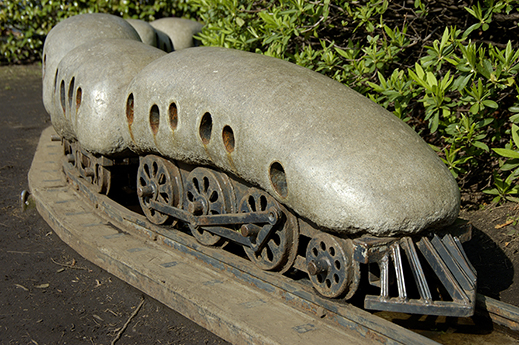 |
|
Bunpei Kado, Rolling Stones (2004), steel and concrete, 4000 x 1000 x 500 mm. |
Surrounding this diorama are a number of other large works that do not necessarily reference railroads, but somehow fit right in. Two of the most delightful are by Bunpei Kado. His Detached-House Condominium is a jungle gym-like stack of little houses that cheerfully reflect the glow from Ichikawa's train as it trundles by. Across the track looms another Kado contraption: three tall, teetering steel-framed objects clad in mottled brown boxes that do indeed weirdly evoke their title, Giraffes. Kado also greets visitors in the museum lobby with Rolling Stones, a hilariously cartoony locomotive that appears to be carved out of rock, like something you might see in an episode of The Flintstones.
|
Takatsugu Kuriyama, Tokyo Arteries (2016), vinyl tubing and acrylic, 3600 x 3600 x 2500 mm. Though their depths are vertically exaggerated, the color-coded tubes accurately represent the spatial relationships of Tokyo's subway lines. |
Taking pride of place in the center of the main gallery is Takatsugu Kuriyama's Tokyo Arteries, a tour de force of colored vinyl tubes that snake hither and yon inside a huge transparent cube. The work looks about as comprehensible as a Jackson Pollock painting, until you learn that it is a faithful 3D reproduction of the Tokyo subway system.
|
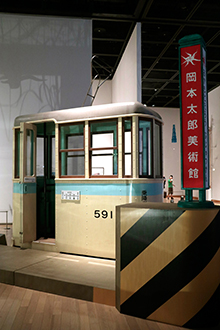 |
|
|
|
Akira Yamaguchi, Streetcar (2010), mixed media, 2190 x 1000 x 2500 mm. |
Probably the most enjoyably absurd take on rail transportation at the show is Akira Yamaguchi's Streetcar, a perfect replica of one of Tokyo's sadly defunct trams, complete with seats, operator controls, a pantograph, and signage -- except the car is barely a meter wide, and the benches are far too narrow to sit on. In accompanying sketches and maps, Yamaguchi explains that he has designed the car to negotiate the narrow alleys of Tokyo's oldest residential neighborhoods -- an utterly impractical notion, and all the more endearing for that.
A separate gallery contains an exhibit of paintings and other two-dimensional art about trains. There are some gems here, too. In addition to the aforementioned sketches, Yamaguchi is represented by Scene of Underground Railroad, one of his classic parodies of traditional Yamato-e screen painting. This one offers a cutaway view of a multi-story subterranean train station, typical of Tokyo -- except this one has slipped back in time to the Meiji or Edo era. Samurai disembark from rickshaws to shuffle through the automatic turnstiles, and one train car is decked out like a Shinto shrine, while another contains a fully operational public bath.
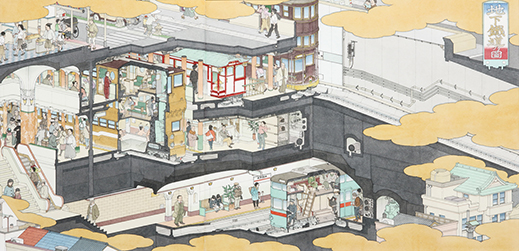 |
|
Akira Yamaguchi, Scene of Underground Railroad (2007), pen and watercolor on paper, 456 x 937 mm. |
Among the most remarkable works in the gallery are the photorealistic paintings of Hisashi Fukushima, a developmentally disabled artist who meticulously reproduces different types of trains and the landscapes they travel through from memory. Though his savant-like talents are something to marvel at, it is his skill with color and composition that captures the eye and the heart.
The museum deserves credit for assembling such a broad spectrum of art for this show. Though the connection between railways and some of the work seems tenuous, to put it mildly, visitors will come away with a renewed appreciation for the intense emotions that trains can inspire, yielding art imbued with everything from obsessive devotion to wacky flights of the imagination.
|
Hisashi Fukushima's painting Arteries of Kawagoe.
|
|
Installation view of Rintaro Hara's Korokoro Diagram (2016). It's hard to tell what some of the exhibits have to do with trains, but kids seem to like them. |
All photos courtesy of the Taro Okamoto Museum of Art, Kawasaki. |
 |
|
| |
7-1-5 Masukata, Tama-ku, Kawasaki, Kanagawa Prefecture
Phone: 044-900-9898
Hours: 9:30 a.m. to 5 p.m., last entry 30 minutes before closing
Closed Mondays (or Tuesday when Monday is a national holiday), the days after national holidays, and year-end holidays
Access: 17-minute walk from the south exit of Mukogaoka-Yuen Station on the Odakyu Line, 20 minutes from Shinjuku by express |
|
|
| |
 |
Alan Gleason
Alan Gleason is a translator, editor and writer based in Tokyo, where he has lived for 30 years. In addition to writing about the Japanese art scene he has edited and translated works on Japanese theater (from kabuki to the avant-garde) and music (both traditional and contemporary). |
|
|
|
|
|
|
|
|
|
 |
|